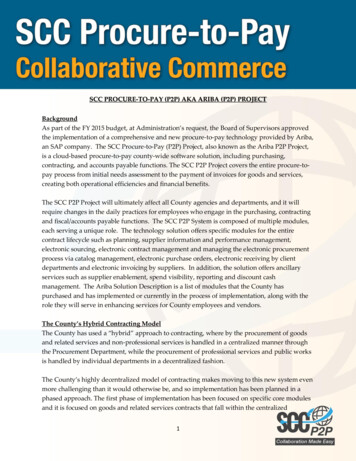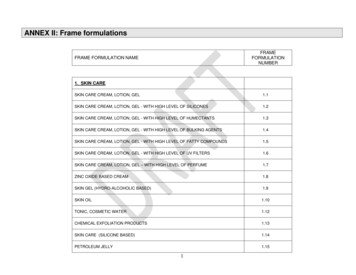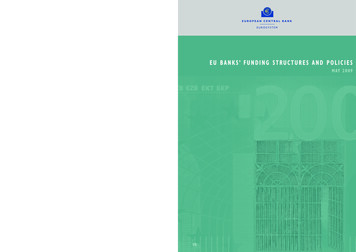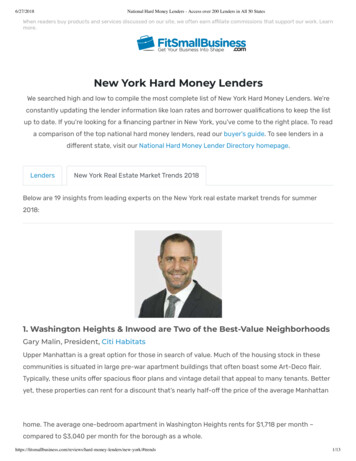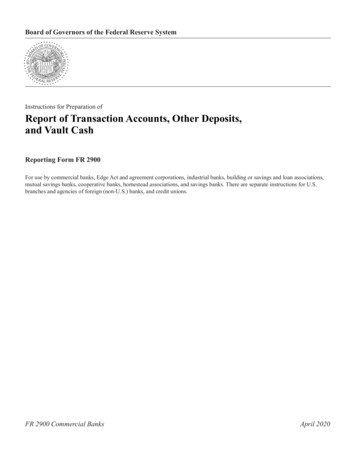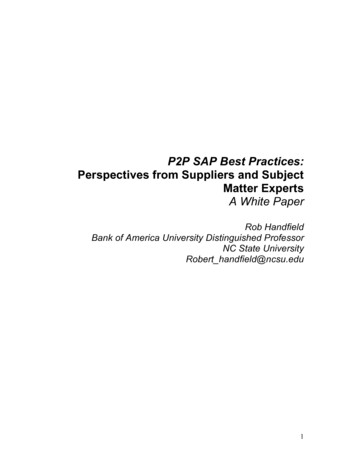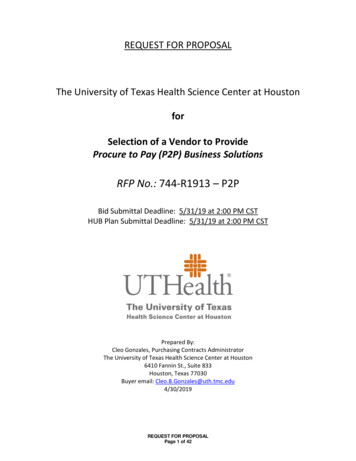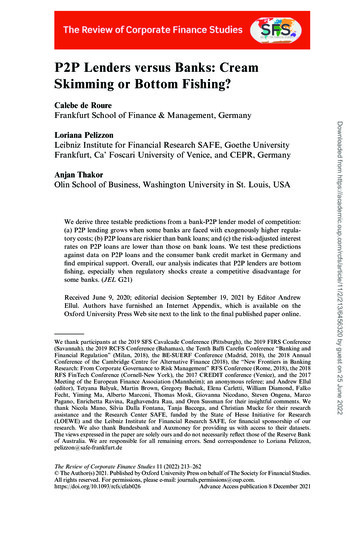
Transcription
P2P Lenders versus Banks: CreamSkimming or Bottom Fishing?Calebe de RoureFrankfurt School of Finance & Management, GermanyAnjan ThakorOlin School of Business, Washington University in St. Louis, USAWe derive three testable predictions from a bank-P2P lender model of competition:(a) P2P lending grows when some banks are faced with exogenously higher regulatory costs; (b) P2P loans are riskier than bank loans; and (c) the risk-adjusted interestrates on P2P loans are lower than those on bank loans. We test these predictionsagainst data on P2P loans and the consumer bank credit market in Germany andfind empirical support. Overall, our analysis indicates that P2P lenders are bottomfishing, especially when regulatory shocks create a competitive disadvantage forsome banks. (JEL G21)Received June 9, 2020; editorial decision September 19, 2021 by Editor AndrewEllul. Authors have furnished an Internet Appendix, which is available on theOxford University Press Web site next to the link to the final published paper online.We thank participants at the 2019 SFS Cavalcade Conference (Pittsburgh), the 2019 FIRS Conference(Savannah), the 2019 RCFS Conference (Bahamas), the Tenth Baffi Carefin Conference “Banking andFinancial Regulation” (Milan, 2018), the BE-SUERF Conference (Madrid, 2018), the 2018 AnnualConference of the Cambridge Centre for Alternative Finance (2018), the “New Frontiers in BankingResearch: From Corporate Governance to Risk Management” RFS Conference (Rome, 2018), the 2018RFS FinTech Conference (Cornell-New York), the 2017 CREDIT conference (Venice), and the 2017Meeting of the European Finance Association (Mannheim); an anonymous referee; and Andrew Ellul(editor), Tetyana Balyuk, Martin Brown, Gregory Buchak, Elena Carletti, William Diamond, FalkoFecht, Yiming Ma, Alberto Marconi, Thomas Mosk, Giovanna Nicodano, Steven Ongena, MarcoPagano, Enrichetta Ravina, Raghavendra Rau, and Oren Sussman for their insightful comments. Wethank Nicola Mano, Silvia Dalla Fontana, Tanja Baccega, and Christian Mucke for their researchassistance and the Research Center SAFE, funded by the State of Hesse Initiative for Research(LOEWE) and the Leibniz Institute for Financial Research SAFE, for financial sponsorship of ourresearch. We also thank Bundesbank and Auxmoney for providing us with access to their datasets.The views expressed in the paper are solely ours and do not necessarily reflect those of the Reserve Bankof Australia. We are responsible for all remaining errors. Send correspondence to Loriana Pelizzon,pelizzon@safe-frankfurt.deThe Review of Corporate Finance Studies 11 (2022) 213–262ß The Author(s) 2021. Published by Oxford University Press on behalf of The Society for Financial Studies.All rights reserved. For permissions, please e-mail: 93/rcfs/cfab026Advance Access publication 8 December 2021Downloaded from 6320 by guest on 25 June 2022Loriana PelizzonLeibniz Institute for Financial Research SAFE, Goethe UniversityFrankfurt, Ca’ Foscari University of Venice, and CEPR, Germany
Review of Corporate Finance Studies / v 11 n 2 2022Contemporary financial intermediation theories assign a pivotal role tobanks as intermediaries between borrowers and savers (e.g., Boyd andPrescott 1986; Coval and Thakor 2005; Diamond 1984; Millon andThakor 1985; Ramakrishnan and Thakor 1984),1 with some emphasizingthe value of deposit-taking and lending within the same institution.2Peer-to-peer (P2P) lending, which directly matches borrowers and lenders without relying on deposits and eliminates an intermediating bank,has gained traction in recent years in Europe, the United States, andChina (see, e.g., Milne and Parboteeah 2016; Federal Reserve Bank ofNew York 2018; Braggion, Manconi, and Zhu 2020; Cornelli et al. 2020).This increase in fintech lending is particularly interesting in light ofFigure 1, which depicts the volume of new consumer loans in Germanyprovided by Auxmoney, the country’s largest P2P platform, and by1In these theories, banks either provide valuable screening to enhance investment efficiency (e.g, Covaland Thakor 2005; Ramakrishnan and Thakor 1984) or more effectively collect repayment from borrowers (e.g., Diamond 1984). The growth of fintech raises the question of whether these advantages havedeclined.2See, for example, Donaldson, Piacentino, and Thakor (2018). In their general equilibrium theory ofbanking, banks create funding liquidity with universal risk neutrality, whereby the aggregate initialinvestment of the economy in real projects exceeds the entire endowment of the economy. Deposittaking is necessary, but not sufficient, for bank liquidity creation; rather, the bank must accept depositsand make loans to create funding liquidity.214Downloaded from 6320 by guest on 25 June 2022Fig. 1New lending by P2P platforms and banksThis figure shows the volume of new consumer loans per quarter of German banks and Auxmoney, thelargest P2P lending platform in Germany. Bank lending refers to nonconstruction consumer credit lines(overdraft credit, lines up to a 1-year maturity, and lines with between 1- and 5-year maturities) in 105Sparkassen and Volksbanken in Germany, and is defined in billions of euros. Auxmoney’s credit provision is defined in millions of euros. The sample period is the first quarter of 2010 until the first quarter of2014. Sources: Research Data and Service Center (RDSC) of the Deutsche Bundesbank, MFI InterestRates Statistics, and Auxmoney.
P2P Lenders versus Banks3Our focus is on the interaction between P2P lending and bank lending, that is, on the changes induced bythis interaction, not on the levels of lending. Nonetheless, as we will discuss later, the volume of newlending by Auxmoney was about equal to that of a midsized bank in our sample by the end of 2018.4In the rest of the paper, we refer to bank and P2P lending as new loans provided by them in a certainperiod, not the actual stock of loans.5In the context of the Merton and Thakor (2019) framework, we view these depositors as “customers”who receive liquidity services in addition to deposit interest and shareholders as “investors” who careonly about their expected pecuniary return.215Downloaded from 6320 by guest on 25 June 2022savings and cooperative banks. As the figure makes clear, new bankloans are trending downward and new P2P loans are trending upward,although the absolute volume of bank lending far exceeds that of P2Plending.3Commonly given explanations for the decline in bank lending relativeto P2P lending point to advances in information technology—those thatdiminish the relative advantage of banks—and a heavier postcrisis regulatory burden on banks.4Regardless of the underlying drivers and the observation that banklending volume far exceeds P2P lending volume at present, these timeseries patterns raise interesting questions about the nature of the competition between P2P lending and (intermediated) bank lending. Underwhat circumstances do banks lose loans to P2P platforms? What arethe risk characteristics of the loans that migrate from banks to P2Pplatforms; that is, are P2P platforms skimming the cream off of bankloans or bottom fishing? Are P2P platforms lending at higher or lowerrisk-adjusted interest rates than banks?Our main goal is to address these questions empirically. As motivationfor the hypotheses we test, we develop a simple theoretical model of bankand P2P lending. Banks in this model are intermediaries between depositors and borrowers and thus finance loans with deposits and their ownequity. Deposits provide valuable liquidity services to depositors.5Leverage on the bank’s balance sheet creates a risk-shifting distortionthat must be attenuated with sufficient bank equity. Each bank alsoincurs a regulatory intermediation cost, which is the price of having access to profitability-enhancing deposits. In contrast, a P2P platform is anonintermediated lender that finances its loans with money from investors. Following Philippon (2016), we view P2P loans as being all-equityfinanced; that is, the platform has no leverage of its own. Access toleverage via rent-producing deposits is a key competitive advantage ofbanks in our model.Our summary statistics indicate that prior to the regulatory capitalshock suffered by banks, about half of the P2P loans were riskier thanthe riskiest bank loans, suggesting that P2P lending is complementary tobank lending; the other half composed loans whose riskiness overlappedwith the riskiness of bank loans, suggesting they are substitutes. We
Review of Corporate Finance Studies / v 11 n 2 2022mainly focus on the impact of an exogenous shock to bank capitalrequirements (which represented an increase in regulatory costs forbanks) on the competitive interaction between banks and P2P lenders,not on the relative magnitudes of substitutability and complementarity.Our theoretical model predicts the following:Thus, our analysis focuses on the impact of higher regulatory costs aswell as the presence of P2P lenders on (a) new lending by banks and (b)new loans by P2P lenders. We confront these predictions of our modelwith data on P2P and bank lending in Germany. The data on P2P lending are provided by Auxmoney, the largest and oldest P2P lending platform for consumer credit in Germany. Data on bank lending come fromthe Deutsche Bundesbank.Because of the differences in origination between P2P and bank lending, we also compare the two data sets by examining risk and interest ratedifferences. Unlike those used by previous studies, our database includesdetailed information on interest rates for new loans and the risk profilesof P2P and bank loans. Using German rather than U.S. data offers someadvantages.6 First, the U.S. consumer lending market is highly heterogeneous: it includes not only banks and P2P lending platforms but also6Because we use German data, one may question the external validity of our analysis. However, ourtheoretical model is free of any specific institutional features of the German credit market, so ourpredictions are generally valid in any setting in which the bulk of consumer lending is done by banksand lending platforms and banks face regulatory costs that exceed those of P2P lenders but have a216Downloaded from 6320 by guest on 25 June 20221. If some banks are subject to an exogenous shock in the form of anunexpected increase in regulatory costs, the unaffected competingbanks increase their lending (at the expense of the affected banks)but only if they are sufficiently well-capitalized. These competingbanks have an advantage over P2P platforms in taking marketshare from the affected banks because of their access to deposits.However, banks in the aggregate lose loan market share to P2Plenders when the unaffected banks are not sufficiently capitalizedto replace the reduction in credit supply from the affected banks.This loss in market share is greater when the preshock awareness ofP2P lending is higher. Thus, our theory presumes the potential substitutability between bank and P2P loans, because it deals with themigration of loans from banks—and the decline of aggregate banklending—following a regulatory shock to some banks.2. Loans pried away by P2P platforms are the riskiest bank loans, sothat bank loan portfolios are subsequently safer. Thus, P2P platforms are bottom fishing.3. The risk-adjusted interest rates on P2P loans are lower than thoseon bank loans.
P2P Lenders versus Banksdeposit-related funding advantage over these platforms. Thus, the external validity of our results is not aconcern.7Nonetheless, evidence from U.S. P2P lending is also consistent with a prediction of our model, namely,that P2P platforms lend to borrowers who are riskier than those served by banks (see Chava et al. 2021;Di Maggio and Yao 2021).8In Germany, these participant banks include Deutsche Bank, Commerzbank, Landesbank BadenWürttemberg, DZ Bank, Bayerische Landesbank, Norddeutsche Landesbank (NordLB), Hypo RealEstate Holding, WestLB, HSH Nordbank, Landesbank Hessen-Thüringen (HELABA), Landesbank,DekaBank, and WGZ Bank.217Downloaded from 6320 by guest on 25 June 2022nonbank lenders like payday and title lenders. By contrast, consumerlending in Germany is primarily handled by banks, and theBundesbank provides good bank-level data. Second, P2P lending platforms in the United States do not serve subprime borrowers. LendingClub and Prosper apply the minimum FICO score cutoffs of 660 and 640,respectively, to define credit-eligible borrowers; subprime borrowers typically have scores below 600.7 Auxmoney does not apply this restriction,and subprime borrowers are also served by P2P lenders. Third, our datainclude interest rates on new loans, which permits a comparison of ratescharged on bank loans and P2P loans. Fourth, the German financialsystem is bank-based, in contrast to the market-based U.S. system.These differences make the German setting ideal for our investigation,and the German data allow us to focus squarely on the impact of P2Plenders on banks in a setting in which banks dominate the credit market.We focus on regional banks (i.e., savings banks [Sparkassen] and cooperative banks [Volksbanken]). These banks have geographical restrictions that facilitate a clean analysis at the bank-state level. Moreover,their primary mandate is to provide credit for the local economy, whichmakes them closer than global banks to the bank described in our model.Our empirical results support the theoretical predictions. To providecausal evidence for our key result (Prediction 1), we employ a quasinatural experiment in which capital requirements for some banks—andhence their regulatory costs—unexpectedly increased because of a newregulation. The experiment is the European Banking Authority (EBA)capital exercise, which occurred in October 2011, a few months after the2011 stress test and the subsequent failure of Dexia bank. The capitalexercise required participant banks to attain a 9% core tier 1 capital ratioby the end of June 2012.8 Two large Landesbanken in Germany reportedlarge capital shortfalls: NordLB and HELABA (about e2.5 billion ande1.5 billion, respectively). Consequently, NordLB had to increase itscapital as a percentage of total assets by about 1.1%, and HELABAhad to increase capital as percentage of total assets by 1% (total assetsof about e228 billion and e151 billion in 2011, respectively). Both represented substantial increases, and the precipitating shock was largelyunexpected. Landesbanken are also known as the “central bank” of
Review of Corporate Finance Studies / v 11 n 2 20229In its 2012 Annual Report, NordLB describes its sources of capital to meet the higher requirements.They include the Association of Savings Banks in Lower Saxony, the Savings Banks HoldingAssociation in Saxony-Anhalt; and the Special Purpose Holding Association of Savings Banks inMecklenburg-Western Pomerania, the State of Lower Saxony, and the State of Bremen. The capitalcame from a cash injection and the conversion of silent participations and other capital instruments.10Numerous papers have examined the impact of higher capital requirements on bank lending. See, forexample, Gropp et al. (2018), who specifically examine the credit supply effect of the EBA exercise.218Downloaded from 6320 by guest on 25 June 2022savings banks, and they are jointly owned by state governments and localsavings banks. NordLB covers savings banks in Lower Saxony, SaxonyAnhalt, and Mecklenburg-Western Pomerania, while HELABA coverssavings banks in Hesse and Thuringia.9 We follow Puri, Rocholl, andSteffen (2011) and link the savings banks to their respectiveLandesbanken. When a Landesbank is required to raise more capital,the savings banks of these states also face higher regulatory costs due totheir links with their Landesbank, since much of the additional capital isprovided by these local savings banks. This has two effects on savingsbanks that both reduce their lending by these banks. One effect is direct:these banks are using loanable funds to purchase equity in theirLandesbanken rather than lending money. The other effect is indirect:the equity investment increases the risk of the savings banks and requiresa higher capital ratio, which de facto increases regulatory costs.Thus, our empirical strategy is to test whether savings banks linked toNordLB and HELABA decreased their lending after the capital exercise,when compared to other savings banks and cooperative banks.10Moreover, we test (a) whether P2P lending rose more in those stateswhere NordLB and HELABA operate and (b) whether this market sharegain was larger when the unaffected banks in the region were financiallyweaker (lower capital ratios) and hence less capable of making up for thereduced credit supply from the affected banks.The capital exercise is a useful shock because it is exogenous to P2Plending and any preshock actions of the affected banks. We exploit thisexogenous variation in the EBA bank selection rule and use a differencein-differences (diff-in-diff) approach to identify the effect of the capitalexercise on (a) overall bank lending in affected states and (b) Auxmoneylending activity in affected states.We find that overall bank lending decreases in states in which banksaffected by the EBA exercise are present. Affected banks reduce theirlending more than unaffected banks in these states. Auxmoney alsoincreases its lending in the treated states and increases it by more if theunaffected banks in these states have low capital ratios.To gain further insight into the effect of P2P lending, we examinewhether the decline in bank lending in the regions with treated banksis affected by the cost to P2P lenders of luring bank borrowers away. Weproxy this poaching cost with a measure of consumer awareness of P2P
P2P Lenders versus Banks11See Morse (2015) and Balyuk and Davydenko (2019). Buchak et al. (2018) point out that many of theseinstitutions are recipients of government safety nets, protection, and subsidies, a scenario that raisesconcerns about the implications of risk spillover.12In the same spirit, Vallee and Zeng (2019) focus on the investor side of P2P lending. Iyer et al. (2016)highlight the importance of soft information for borrower screening, and Butler, Cornaggia, and Gurun(2017) show that good access to local bank financing causes consumers who seek P2P loans to do so atlower interest rates. Hertzberg, Liberman, and Paravisini (2018) use P2P lending data to show that loanmaturity can be used as a screening device.219Downloaded from 6320 by guest on 25 June 2022lenders, the idea being that greater awareness implies a lower poachingcost. Consumer awareness is measured by their Google search for“Auxmoney” in the treated states before the capital exercise. We document that Auxmoney experienced a larger increase in loan volume whenconsumers searched more often for the word “Auxmoney” prior to thecapital exercise. We also verify that, subsequent to the capital shock,these internet searches increased more in treated states than in controlstates.We then test Prediction 2 of our model, that P2P lenders pry away theriskiest borrowers from banks, thereby leaving banks with a safer borrower pool. Consistent with this prediction, we find that bank portfoliosare less risky after the regulatory shock, whereas P2P lending becomesriskier.Finally, we test Prediction 3 by examining risk-adjusted interest rates,and find that banks charge higher risk-adjusted interest rates than P2Plenders.Although P2P lending in its present form is a relatively recent phenomenon that started in 2005 with the launch of Zopa, research interesthas grown since Prosper (a competitor of Zopa) made the data for itsentire platform available in 2007 (see, e.g., Pope and Sydnor 2011; Lin,Prabhala, and Viswanathan 2013; Morse 2015). P2P lending today is notlimited to the peer-to-peer retail lending that marked its earliest days.Rather, the investors now include hedge funds and large institutions.11Also relevant is the growing literature on fintech, which includes P2Plending as a component. Examples are Philippon (2015, 2016),Greenwood and Scharfstein (2013), and Buchak et al. (2018).Philippon (2016) argues that fintech can bring about efficiencyenhancing structural change in the financial services industry, but thatpolitical economy factors may impede that effect. Greenwood andScharfstein (2013) emphasize that shadow banking activities, such asP2P lending, significantly facilitate higher household credit. Buchaket al. (2018) find that fintech firms set interest rates that are more predictive of ex post default rates than rates set by banks in the U.S. residential mortgage market.12 A contemporaneous paper by Tang (2020)examines whether bank and P2P lending are complements or substitutes.Using a change in U.S. accounting rules that required banks to consolidate some off-balance-sheet securitization vehicles (with FAS 166/167)
Review of Corporate Finance Studies / v 11 n 2 202213For example, our shock is both qualitatively and quantitatively different from that used by Tang (2020).We argue that our bank capital shock was unexpected and quite sudden. The absence of contemporaneous changes for P2P lenders permits a sharp delineation of the timing of the shock and facilitates ouridentification. We provide evidence of the lack of anticipation of the regulatory change.14Tang (2020) examines whether bank and P2P loans are complements or substitutes. Although we findevidence similar to Tang’s, her question is not our focus. However, our reallocation analysis sheds lighton an important unanswered question in Tang (2020): given the heterogeneity among banks becauseFAS 166/167 did not affect all banks, why did nontreated banks not fill the “lending vacuum” created bythe treated banks? This question is relevant in the context of earlier research that provides evidence ofcredit reallocation in response to systemic shocks (e.g., Berger and Bouwman 2013). We show that theability of nontreated banks to react in this way depends on their capital ratios.15The reason for this in our theory is different from the technological advantage in analyzing big datasuggested in Buchak et al. (2018). They define fintech to include all types of financial-technology-assisted220Downloaded from 6320 by guest on 25 June 2022as a negative shock to bank credit supply, the paper documents that P2Plending in the U.S. is a substitute for bank lending in that it servesinframarginal bank borrowers, and is a complement for small loans.Thakor (2020) reviews this literature, and discusses various aspects offintech, with a focus on the relationship between bank and P2P lending.Our paper differs from this literature in various ways. First, unlike theabove papers, we develop a theoretical model in which (a) intermediationcosts for banks, (b) their role in providing liquidity services to depositors,(c) bank leverage, and (d) competition among banks and with P2P lenders are all elements that interact to generate predictions about the kindsof loans that will migrate from banks to P2P platforms. The theoryilluminates the specific channels through which an increase in capitalrequirements for some banks leads to P2P lenders lending more andhighlights the dependence of this market share gain by P2P lenders onthe capital structure of the banks unaffected by the regulatory shock.Second, this theory then permits us to use a shock to bank capital thatdiffers from shocks considered in previous papers.13 The fact that thisshock affected banks heterogeneously allows us to examine its impact onsubgroups of banks, aggregate bank lending, and on P2P lending, as wellas the associated reallocation effects. This investigation leads to a nuanced view of the interaction between bank and P2P lending. Specifically,we document—consistent with the predictions of our model—that whenbanks face higher regulatory costs, the riskiest bank loans migrate to P2Plenders, causing declines in average risk in both bank lending and overallbank lending. This shift happens more when the unaffected banks in theregion are capital constrained. None of these results appears in the previous literature. For example, Tang (2020) does not have any of ourresults on the supply of aggregate bank credit and credit reallocationeffects across banks in response to a bank capital shock.14Third, we also document that P2P loans have lower risk-adjusted interest rates than do banks. This finding is in sharp contrast to that ofBuchak et al. (2018),15 and is a finding not yet encountered in the priorliterature.
P2P Lenders versus Banks1. Theory and PredictionsIn this section, we develop a theoretical model that generates testablepredictions about how bank lending is affected by competition betweenP2P lenders and banks.1.1 The modelConsider an economy in which all agents are risk neutral and the risklessrate is zero. There are banks, each of which has a borrower. Each borrower always has the possibility that a competing bank could bid fortheir business. For a competing bank, the cost of acquiring a borrowerwho is presently with another bank is a B , which represents the cost ofprying away a borrower who has a loan from the incumbent bank. Thevariable a B comprises (a) a random variable, a 0, and (b) a deterministic function, bðsÞ 0, where s represents the strength of the incumbentbank’s relationship with its borrower; that is, a B ¼ a þ bðsÞ. We assumethat @b@s 0 to indicate that the prying cost for a competitor increases asthe strength of the incumbent bank’s relationship with the borrowerincreases. The realization of a , which we refer to as a, becomes commonknowledge at t ¼ 0, before competition between lenders begins. Similarly,a P2P platform also faces a borrower acquisition cost a P in prying away aborrower from a bank, where a P a þ bðsÞ þ cðwÞ, w represents aware@c 0, withness of P2P lending on the part of the borrowers and @wlimw!1 c ¼ 0. We assume that cðwÞ 0 and a B a P .The sequence of events is as follows. There are two dates: t ¼ 0, 1. Att ¼ 0, the bank has a borrower who needs a loan of L 0. The winningbank contracts with the borrower to repay LR at t ¼ 1 in exchange for aloan of L at t ¼ 0. Once LR is determined, the bank defines its capitallending, not just P2P loans, whereas we focus on P2P loans. Thus, ours is a more direct comparison ofbanks (which may use fintech) and P2P lenders.221Downloaded from 6320 by guest on 25 June 2022Finally, we show that borrowers’ pre-capital-shock awareness of P2Plending correlates with how the shock affected the migration of bankloans to P2P platforms. Greater awareness is related to higher migration.In summary, to the best of our knowledge, our paper is the first toshow that when some banks are hit with a capital shock, the effect of thison P2P lending, bank lending, and loan interest rates, depends on thecapital levels of unaffected banks and consumer awareness of P2P lending,and that the bank loans that P2P platforms pry away have lower riskadjusted interest rates than the rates on bank loans. In this respect, ourpaper also differs from papers that examine the interbank credit reallocation consequences of a capital shock suffered by some banks (e.g.,Bord, Ivashina, and Taliaferro 2021).
Review of Corporate Finance Studies / v 11 n 2 2022structure for financing the loan. At t ¼ 1, the borrower’s project (financed with the loan) either pays off or does not pay off. The loan isrepaid in full if the project pays off, and defaults if the project fails.1.1.2 Loan types. There are two good loans of varying risk: g and G.The g loan is associated with a borrower whose project pays off xb withprobability (w.p.) q 2 ð0; 1Þ and 0 w.p. 1 q. The maximum pledgeablecash flow that this borrower has to repay the loan is x 2 ð0; xb . The Gloan is associated with a borrower whose project pays off xb w.p. p and 0w.p. 1 p. The maximum pledgeable cash flow to repay the loan is also xfor this borrower. The payoffs on G and g are random variables. Whetherthe bank has g or G is exogenously specified for now.17 In the crosssection of banks, some banks have g and some have G. Regardless ofwhether a bank has g or G, it has the option to unobservably investinstead in a loan, call it B, that generates a private benefit of P 0 forbank insiders (i.e., the manager who is also the inside shareholder) but nocontractible payoff for outside financiers (i.e., depositors).18 This moralhazard in lending is similar to that in Holmstrom and Tirole (1997).Further, banks’ specialization in monitoring (e.g., Holmstrom andTirole 1997) and screening (e.g., Ramakrishnan and Thakor 1984) maygive them an advantage over P2P lenders in controlling borrower risk. To16The assumption that XðDÞ is increasing in D is in Merton and Thakor (2019).17In Section 1.2, we will discuss what happens if the bank has both G and g.18One can think about this loan in many ways. For example, the loan could be made to a family memberor a friend.222Downloaded from 6320 by guest on 25 June 20221.1.1 Intermediation cost. In exchange for being given access to depositfunding (D), banks must abide by regulations and agree to be supervisedby regulatory authorities. Without specifying the details of these regulations, we stipulate the “regulatory cost of intermediation” to the bank tobe K 0. We assume that the social cost of bank failure is XðDÞ 0,which is increasing and convex in D.16 To minimize this cost, the
lending in Germany is primarily handled by banks, and the Bundesbank provides good bank-level data. Second, P2P lending plat-forms in the United States do not serve subprime borrowers. Lending Club and Prosper apply the minimum FICO score cutoffs of 660 and 640, respectively, to define credit-eligible borrowers; subprime borrowers typ-

